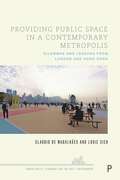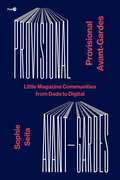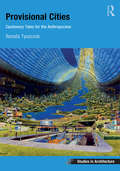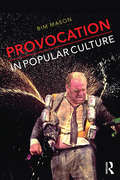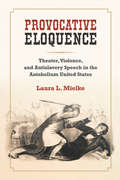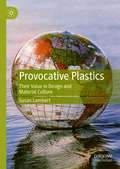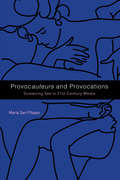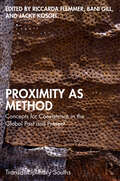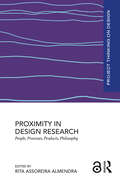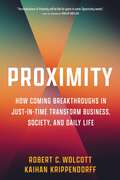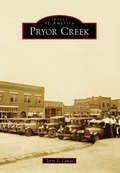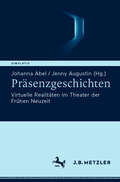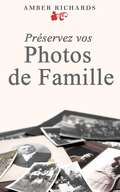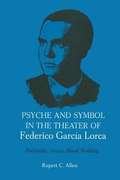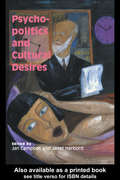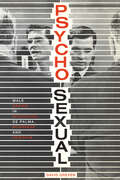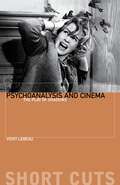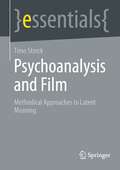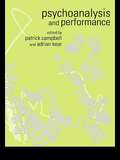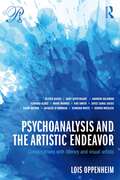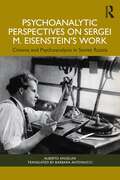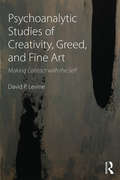- Table View
- List View
Providing Public Space in a Contemporary Metropolis: Dilemmas and Lessons from London and Hong Kong (Urban Policy, Planning and the Built Environment)
by Louie Sieh Claudio De MagalhãesIncreasingly, public space provision and management are being transferred from the public sector to real estate developers, private sector organisations, voluntary groups and community bodies. Contrasting the more historical, horizontal character of London with the intense street life of high-rise Hong Kong, this book tells the story of the two cities’ relationships with non-traditional forms of public space governance. The authors consider the implications for the ‘publicness’ of these complex spaces and the challenges and impacts that different forms of provision have on those with a stake in them, and on the cities as a whole.
Provisional Avant-Gardes: Little Magazine Communities from Dada to Digital (Post*45)
by Sophie SeitaWhat would it mean to be avant-garde today? Arguing against the notion that the avant-garde is dead or confined to historically "failed" movements, this book offers a more dynamic and inclusive theory of avant-gardes that accounts for how they work in our present. Innovative in approach, Provisional Avant-Gardes focuses on the medium of the little magazine—from early Dada experiments to feminist, queer, and digital publishing networks—to understand avant-gardes as provisional and heterogeneous communities. Paying particular attention to neglected women writers, artists, and editors alongside more canonical figures, it shows how the study of little magazines can change our views of literary and art history while shedding new light on individual careers. By focusing on the avant-garde's publishing history and group dynamics, Sophie Seita also demonstrates a new methodology for writing about avant-garde practice across time, one that is applicable to other artistic and non-artistic communities and that speaks to contemporary practitioners as much as scholars. In the process, she addresses fundamental questions about the intersections of aesthetic form and politics and about what we consider to be literature and art.
Provisional Cities: Cautionary Tales for the Anthropocene (Ashgate Studies in Architecture)
by Renata TyszczukThis book considers the provisional nature of cities in relation to the Anthropocene – the proposed geological epoch of human-induced changes to the Earth system. It charts an environmental history of curfews, admonitions and alarms about dwelling on Earth. ‘Provisional cities’ are explored as exemplary sites for thinking about living in this unsettled time. Each chapter focuses on cities, settlements or proxy urbanisations, including past disaster zones, remote outposts in the present and future urban fossils. The book explores the dynamic, changing and contradictory relationship between architecture and the global environmental crisis and looks at how to re-position architectural and urban practice in relation to wider intellectual, environmental, political and cultural shifts. The book argues that these rounder and richer accounts can better equip humanity to think through questions of vulnerability, responsibility and opportunity that are presented by immense processes of planetary change. These are cautionary tales for the Anthropocene. Central to this project is the proposition that living with uncertainty requires that architecture is reframed as a provisional practice. This book would be beneficial to students and academics working in architecture, geography, planning and environmental humanities as well as professionals working to shape the future of cities.
Provocation in Popular Culture
by Bim MasonWhat role can provocation play in the process of renewal, both of individuals and of societies? Provocation in Popular Culture is an investigation into the practice of specific provocateurs and the wider nature of cultural provocation, examining, among others: Banksy Sacha Baron Cohen Leo Bassi Pussy Riot Philippe Petit Archaos. Drawing on Bim Mason’s own twenty-five year career as performer, teacher and creative director, this book explores the power negotiations involved in the relationship between provocateur and provoked, and the implications of maintaining a position on the ‘edge’. Using neuroscience as a bridge, it proposes a similarity between complexity theory and cultural theories of play and risk. Three inter-related analogies for the ‘edge’ on which these performers operate – the fulcrum, the blade and the border – reveal the shifts between structure and fluidity, and the ways in which these can combine in a single moment.
Provocative Eloquence: Theater, Violence, and Antislavery Speech in the Antebellum United States
by Laura L MielkeIn the mid-19th century, rhetoric surrounding slavery was permeated by violence. Slavery’s defenders often used brute force to suppress opponents, and even those abolitionists dedicated to pacifism drew upon visions of widespread destruction. Provocative Eloquence recounts how the theater, long an arena for heightened eloquence and physical contest, proved terribly relevant in the lead up to the Civil War. As antislavery speech and open conflict intertwined, the nation became a stage. The book brings together notions of intertextuality and interperformativity to understand how the confluence of oratorical and theatrical practices in the antebellum period reflected the conflict over slavery and deeply influenced the language that barely contained that conflict. The book draws on a wide range of work in performance studies, theater history, black performance theory, oratorical studies, and literature and law to provide a new narrative of the interaction of oratorical, theatrical, and literary histories of the nineteenth-century U.S.
Provocative Plastics: Their Value in Design and Material Culture
by Susan LambertPlastics have now been our most used materials for over fifty years. This book adopts a new approach, exploring plastics’ contribution from two perspectives: as a medium for making and their value in societal use. The first approach examines the multivalent nature of plastics materiality and their impact on creativity through the work of artists, designers and manufacturers. The second perspective explores attitudes to plastics and the different value systems applied to them through current research undertaken by design, materials and socio-cultural historians. The book addresses the environmental impact of plastics and elucidates the ways in which they can and must be part of the solution. The individual viewpoints are provocative and controversial but together they present a balanced and scholarly un-picking of the debate that surrounds this ubiquitous group of materials. The book is essential reading for a wide academic readership interested in the Arts and Humanities, especially Design and Design History; Anthropology; and Cultural, Material and Social Histories.
Provocauteurs and Provocations: Screening Sex in 21st Century Media
by Maria San FilippoTwenty-first century media has increasingly turned to provocative sexual content to generate buzz and stand out within a glut of programming. New distribution technologies enable and amplify these provocations, and encourage the branding of media creators as "provocauteurs" known for challenging sexual conventions and representational norms.While such strategies may at times be no more than a profitable lure, the most probing and powerful instances of sexual provocation serve to illuminate, question, and transform our understanding of sex and sexuality. In Provocauteurs and Provocations, award-winning author Maria San Filippo looks at the provocative in films, television series, web series and videos, entertainment industry publicity materials, and social media discourses and explores its potential to create alternative, even radical ways of screening sex. Throughout this edgy volume, San Filippo reassesses troubling texts and divisive figures, examining controversial strategies—from "real sex" scenes to scandalous marketing campaigns to full-frontal nudity—to reveal the critical role that sexual provocation plays as an authorial signature and promotional strategy within the contemporary media landscape.
Proximity as Method: Concepts for Coexistence in the Global Past and Present (Transdisciplinary Souths)
by Riccarda Flemmer Bani Gill Jacky KosgeiThis book examines proximity as a benchmarked concept that can be deployed across a range of humanities disciplines to rethink the ways in which existences in the world are always already coexistences – and to parse the heuristic, ethical, epistemological, praxeological consequences of this recognition.The volume:- Brings together diverse theoretical approaches and utilizes a range of methodological instruments – conceptual, textual-analytic (whether in the realm of literary or religious studies, or theology or law), archival, digital, sociological or politological;- Includes empirical case-studies that allow calibrated and scaled exemplifications;- Launches forays onto unexplored conceptual terrain, or call into question hallowed truths of scholarly procedure.The volume will be essential reading for students and early researchers in the social sciences and the humanities.
Proximity in Design Research: People, Processes, Products, Philosophy (Project Thinking on Design)
by Rita Assoreira AlmendraProximity in Design Research explores four constituents of design: people, processes, products and philosophy, and their potential to bridge contemporary gaps through multilevel synergies.The book brings together a variety of design approaches on several scales developed in the collaboration of different agencies and within diverse contexts. Proximity prompts us to explore the challenges and opportunities for research in design, with the widening and closing of distances in unpredictable times such as those during the COVID-19 pandemic. Despite the social distance imposed during this unprecedented global health scenario, researchers and professionals across different areas of knowledge have engaged in an extraordinary interdisciplinary and transdisciplinary global cooperation. This reinvented proximity enhanced the ability to cross fields, remove boundaries to collaboration between disciplines and accelerate processes towards an overarching goal: to overcome adversity. This edited collection reflects on what designers have taken from this experience so far and the possibilities that are foreseen as the concept of proximity is redefined.This book offers critical knowledge related to both design practice and design theory. It will be of interest to researchers, teachers and students working in the design disciplines.
Proximity: How Coming Breakthroughs in Just-in-Time Transform Business, Society, and Daily Life
by Kaihan Krippendorff Robert C. WolcottWhat if you could have whatever you want, produced and provided immediately and affordably no matter how customized—with minimal environmental impact? Products, services, and experiences on demand. Just-in-time anything, anywhere, anytime. This radical change is underway, as digital technologies push the production and provision of value ever closer to the moment of demand.Robert C. Wolcott and Kaihan Krippendorff provide an indispensable guide to the Proximity revolution, showing how it’s transforming every industry—and our lives. Offering unparalleled foresight for leaders and innovators, they reveal how pervasive this trend will be. Proximity represents an entirely new way to serve customers, with critical implications for corporate strategy, investing, public policy, supply chain resilience, and sustainability. Incremental changes to existing business models won’t suffice.Through interviews and compelling examples, Proximity shares stories of the people and companies leading the way. The book places rapidly advancing technologies—from generative AI and 3D printing to lab-grown meats, renewable energy, and virtual reality—in context and explores the factors accelerating the transformation.Proximity offers a playbook for business leaders, investors, and entrepreneurs to win this rapidly emerging game—and for each of us to consider the implications for our careers, families, communities, and lives.
Pruitt-Igoe (Images of America)
by Bob HansmanIn the early 1950s, Pruitt-Igoe, a vast public housing project, arose on 57 acres on the near north side of St. Louis. Barely 20 years after construction, the 33 eleven-story buildings that made up the complex were razed, and the vacant land that was once home to thousands of people was gradually reclaimed by a dense, neglected urban forest. What happened in-between is a story that tempts but also defies simple narratives. It is a story of interweaving and competing accounts, both then and now. This volume approaches Pruitt-Igoe with all of its contradiction in mind. Alongside iconic images, other seldom-seen photographs flesh out the history in sometimes surprising ways and, in doing so, preserve some of the stories that are in danger of being permanently erased and lost, just as Pruitt-Igoe was.
Pryor Creek (Images of America)
by Terry D. LamarPryor Creek, originally named Coo-y-yah (Cherokee for "huckleberry"), incorporated as a city in 1894. Also known as Pryor by the US Postal Service, it is located in northeastern Oklahoma and is the seat of Mayes County. The community is rich with history that dates back to its early days as Indian Territory, where many early residents settled after suffering a grueling journey on the Trail of Tears from the old Cherokee Nation. After starting as a rural farming community, with the addition of the railroad in 1870 Pryor Creek grew to become a major industrial economic force in the region following World War II. During the war, the area was home to a massive ammunition ordnance plant, which eventually became the largest industrial park in Oklahoma. In 1942, Pryor Creek's downtown business district was destroyed by the fifth-deadliest tornado in Oklahoma history. Pryor Creek is also a "gateway" known for its regional lakes and recreational areas.
Präsenzgeschichten: Virtuelle Realitäten im Theater der Frühen Neuzeit (Simulatio. Theatertechniken in Literatur, Medien und Wissenschaft)
by Jenny Augustin Johanna AbelBei einem Blick auf virtuelle Realitäten im frühneuzeitlichen Theater gilt es, unsere vom digitalen Zeitalter geprägten Konzepte der Virtualität und Präsenz zu revidieren. Auf dem Gebiet der Kulturen der Romania haben multiple Präsenz- und Virtualitätsverständnisse eine lange und kontroverse Geschichte. In der Auseinandersetzung mit der Vorgeschichte erweiterter Realitätserfahrungen am Modell des Theaters geht es vor allem um die Einbettung von Vergegenwärtigungstechniken in verflochtene Geschichten und vielschichtige Narrationen vom wirkmächtig Virtuellen. Hier werden daher Präsenzgeschichten im Plural in diversen Medien und epistemischen Erzeugungskontexten durchgespielt.
Préservez Vos Photos De Famille
by Amber Richards Chimène ElessaVos photos de famille ont certainement de l’importance pour vous. Grâce au présent guide, vous ne prendrez pas le risque de prendre à tout jamais ces trésors irremplaçables. En effet, nos photos de famille sont des biens inestimables. Ce sont les archives visuelles de nos souvenirs et de nos proches. Elles méritent un soin particulier pour durer longtemps et pour pouvoir être transmises à la génération suivante. De nombreuses personnes qui s’intéressent à la généalogie possèdent des collections de photos de famille vintage qui, pour être préservées, doivent être entretenues de façon encore plus soignée. Suivez les étapes pratiques pour protéger vos photos de famille, qu’elles soient classiques ou en format numérique. Assurez-vous la longévité de vos trésors et évitez de faire face à leur perte tragique. Téléchargez dès maintenant votre exemplaire.
Pseudo-Public Spaces in Chinese Shopping Malls: Rise, Publicness and Consequences (Routledge Complex Real Property Rights Series)
by Yiming WangShopping malls in China create a new pseudo-public urban space which is under the control of private or quasi-public power structure. As they are open for public use, mediated by the co-mingling of private property rights and public meanings of urban space, the rise, publicness and consequences of the boom in the construction of shopping malls raises major questions in spatial political economy and magnifies existing theoretical debates between the natural and conventional schools of property rights. In examining these issues this book develops a theoretical framework starting with a critique of the socio-spatial debate between two influential bodies of work represented by the work of Henri Lefebvre and David Harvey. Drawing on the framework, the book examines why pseudo-public spaces have been growing so rapidly in China since the 1980s; assesses to what degree pseudo-public spaces are public, and how they affect the publicness of Chinese cities; and explores the consequences of their rise. Findings of this book provide insights that can help to better understand Chinese urbanism and also have the potential to inform urban policy in China. This book will be of interest to academics and researchers in both Chinese studies and urban studies.
Psyche and Symbol in the Theater of Federico García Lorca: Perlimplín, Yerma, Blood Wedding
by Rupert C. AllenSymbol and psyche are twin concepts in contemporary symbological studies, where the symbol is considered to be a "statement" by the psyche. The psyche is a manifold of conscious and unconscious contents, and the symbol is their mediator. Because Lorca's dramatic characters are psychic entities made up of both conscious and unconscious elements, they unfold, grow, and meet their fate in a dense realm of shifting symbols.
Psycho-Politics And Cultural Desires
by Jan Campbell Jan HarbordA cultural studies textbook that deals with issues of methodology, as well as mapping out the history and theories and ideas in cultural studies. The book examines the work of Raymond Williams, Lacan and Hoggart, among Others, And Explores Notions Of Subculture, Psychoanalysis, Marxist thought, narrative, autobiography, fiction, subjectivity, language, history and representation. The book focuses on the past, present and future of cultural studies, with the aim of providing readers with a clear overview of the central ideas within the area, developing current debates and possible future avenues.
Psycho-Sexual: Male Desire in Hitchcock, De Palma, Scorsese, and Friedkin
by David GrevenBridging landmark territory in film studies, Psycho-Sexual is the first book to apply Alfred Hitchcock’s legacy to three key directors of 1970s Hollywood—Brian De Palma, Martin Scorsese, and William Friedkin—whose work suggests the pornographic male gaze that emerged in Hitchcock’s depiction of the voyeuristic, homoerotically inclined American man. Combining queer theory with a psychoanalytic perspective, David Greven begins with a reconsideration of Psycho and the 1956 remake of The Man Who Knew Too Much to introduce the filmmaker’s evolutionary development of American masculinity. Psycho-Sexual probes De Palma’s early Vietnam War draft-dodger comedies as well as his film Dressed to Kill, along with Scorsese’s Taxi Driver and Friedkin’s Cruising as reactions to and inventive elaborations upon Hitchcock’s gendered themes and aesthetic approaches. Greven demonstrates how the significant political achievement of these films arises from a deeply disturbing, violent, even sorrowful psychological and social context. Engaging with contemporary theories of pornography while establishing pornography’s emergence during the classical Hollywood era, Greven argues that New Hollywood filmmakers seized upon Hitchcock’s radical decentering of heterosexual male dominance. The resulting images of heterosexual male ambivalence allowed for an investment in same-sex desire; an aura of homophobia became informed by a fascination with the homoerotic. Psycho-Sexual also explores the broader gender crisis and disorganization that permeated the Cold War and New Hollywood eras, reimagining the defining premises of Hitchcock criticism.
Psychoanalysis and Cinema (AFI Film Readers)
by E. Ann KaplanThese fifteen carefully chosen essays by well-known scholars demonstrate the vitality and variety of psychoanalytic film criticism, as well as the crucial role feminist theory has played in its development. Among the films discussed are Duel in the Sun, The Best Years of Our Lives, Three Faces of Eve, Tender is the Night, Pandora's Box, Secrets of the Soul, and the works of Jacques Tourneur (director of The Cat People and other features).
Psychoanalysis and Cinema: The Play of Shadows (Short Cuts)
by Vicky LebeauLebeau examines the long and uneven history of developments in modern art, science, and technology that brought pychoanalysis and the cinema together towards the end of the nineteenth century. She explores the subsequent encounters between the two: the seductions of psychoanalysis and cinema as converging, though distinct, ways of talking about dream and desire, image and illusion, shock, and sexuality. Beginning with Freud's encounter with the spectacle of hysteria on display in fin-de-siècle Paris, this study offers a detailed reading of the texts and concepts which generated the field of psychoanalytic film theory.
Psychoanalysis and Film: Methodical Approaches to Latent Meaning (essentials)
by Timo StorckThis essential is dedicated to the connection between psychoanalysis and film. Psychoanalysis is suitable for a methodically guided film viewing. This is not an application of psychoanalytical theory, but rather an application of its method of a reflected relationship to a counterpart. In this way, latent meanings can be taken into consideration and an interpretation can be developed. This essential reconstructs the possibilities of such an approach and presents existing approaches. Finally, a guideline for carrying out a film psychoanalytical interpretation is proposed. Numerous film examples serve to illustrate this.The translation was done with the help of artificial intelligence. A subsequent human revision was done primarily in terms of content.
Psychoanalysis and Performance
by Adrian Kear Patrick CampbellThe field of literary studies has long recognised the centrality of psychoanalysis as a method for looking at texts in a new way. But rarely has the relationship between psychoanalysis and performance been mapped out, either in terms of analysing the nature of performance itself, or in terms of making sense of specific performance-related activities. In this volume some of the most distinguished thinkers in the field make this exciting new connection and offer original perspectives on a wide variety of topics, including: · hypnotism and hysteria · ventriloquism and the body · dance and sublimation · the unconscious and the rehearsal process · melancholia and the uncanny · cloning and theatrical mimesis · censorship and activist performance · theatre and social memory. The arguments advanced here are based on the dual principle that psychoanalysis can provide a productive framework for understanding the work of performance, and that performance itself can help to investigate the problematic of identity.
Psychoanalysis and the Artistic Endeavor: Conversations with literary and visual artists (Psychoanalysis in a New Key Book Series)
by Lois OppenheimPsychoanalysis and the Artistic Endeavor offers an intriguing window onto the creative thinking of several well-known and highly creative individuals. Internationally renowned writers, painters, choreographers, and others converse with the author about their work and how it has been informed by their life experience. Creative process frames the discussions, but the topics explored are wide-ranging and the interrelation of the personal and professional development of these artists is what comes to the fore. The conversations are unique in providing insight not only into the art at hand and into the perspective of each artist on his or her own work, but into the mind from which the work springs. The interviews are lively in a way critical writing by its very nature is not, rendering the ideas all that much more accessible. The transcription of the live interview reveals the kind of reflection censored elsewhere, the interplay of personal experience and creative process that are far more self-consciously shaped in a text written for print. Neither private conversation nor public lecture, neither crafted response (as to the media) nor freely associative discourse (as in the analytic consulting room), these interviews have elements of all. The volume guides the reader toward a deeper psychologically oriented understanding of literary and visual art, and it engages the reader in the honest and often-provocative revelations of a number of fascinating artists who pay testimony to their work in a way no one else can. This is a unique collection of particular interest for psychoanalysts, scholars, and anyone looking for a deeper understanding of the creative process.
Psychoanalytic Perspectives on Sergei M. Eisenstein's Work: Cinema and Psychoanalysis in Soviet Russia
by Alberto AngeliniIn this insightful book, Alberto Angelini shows the influence of psychoanalysis and psychology on Sergei M. Eisenstein, one of the most celebrated Russian directors, and his cinematic output. Angelini situates Eisenstein’s life and oeuvre in the history and culture of twentieth-century Russia, drawing clear parallels between his networking with key figures such as Lev Vygotsky and Aleksandr Luria. He utilises the tools of psychology with the insight of psychoanalysis to illuminate the ways in which Eisenstein understood art as an anthropological enterprise while maintaining the same dialectical philosophy as the director in highlighting the many disciplines and figures that he drew inspiration from. Angelini also looks in depth at the influence psychoanalytic theories of regression had on Eisenstein’s approach to art, while examining the impact Stalinism had directly on both Eisenstein and psychoanalysis at large from the 1930s onwards. This book is an essential resource for psychoanalysts, students, and scholars of film studies, as well as those interested in the intersection between psychoanalytic theory, cinema, and the arts.
Psychoanalytic Studies of Creativity, Greed, and Fine Art: Making Contact with the Self
by David P LevineThroughout the history of psychoanalysis, the study of creativity and fine art has been a special concern. Psychoanalytic Studies of Creativity, Greed and Fine Art: Making Contact with the Self makes a distinct contribution to the psychoanalytic study of art by focusing attention on the relationship between creativity and greed. This book also focuses attention on factors in the personality that block creativity, and examines the matter of the self and its ability to be present and exist as the essential element in creativity. Using examples primarily from visual art David Levine explores the subjects of creativity, empathy, interpretation and thinking through a series of case studies of artists, including Robert Irwin, Ad Reinhardt, Susan Burnstine, and Mark Rothko. Psychoanalytic Studies of Creativity, Greed and Fine Art explores the highly ambivalent attitude of artists toward making their presence known, an ambivalence that is evident in their hostility toward interpretation as a way of knowing. This is discussed with special reference to Susan Sontag's essay on the subject of interpretation. Psychoanalytic Studies of Creativity, Greed and Fine Art contributes to a long tradition of psychoanalytically influenced writing on creativity including the work of Deri, Kohut, Meltzer, Miller and Winnicott among others. It will be of interest to psychoanalysts, psychoanalytic psychotherapists, historians and theorists of art.
